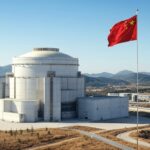 [[{“value”:”
[[{“value”:”
ENB Pub Note: If China can build a reactor for 2.74 billion each, and build them for that, we had better get a huge plan together from the leadership at the U.S. Department of Energy. The last reactor activated in the United States is part of the $35 billion project. That was for the Vogtle Unit 4, and I am clarifying if that was for two or all four reactors. We are way off base at 17 billion per reactor compared to the 2.74 per reactor and need to look at our business practices and designs. Cutting regulations can only get you to a certain percentage, and you must realize our designs may be totally off base.
Key Points
-
Research suggests China approved 10 new nuclear reactors in April 2025, boosting its clean energy transition.
-
It seems likely that China’s current nuclear capacity is around 57 GW, with a share of about 5% in total electricity generation.
Current Nuclear Approvals
China’s State Council approved 10 new nuclear reactors on April 27, 2025, as part of five projects in coastal provinces like Guangdong and Fujian. This continues a trend of approving at least 10 reactors annually since 2022, with an estimated investment of $27.4 billion. Each reactor, using domestic technologies like Hualong One, has a capacity of about 1.2 GW, enhancing China’s nuclear leadership by 2030.
Total Mix to the China Grid
The evidence leans toward China’s current nuclear installed capacity being approximately 56.9 GW from 58 operating reactors, based on recent data. In 2024, nuclear power accounted for 4.72% of total electricity generation, producing 444.7 billion kWh. Given 2025 is ongoing, the share is likely similar until new reactors operate, contributing around 5% to the grid.
Survey Note: Detailed Analysis of China’s Nuclear Reactor Approvals and Grid Contribution
This survey note provides a comprehensive analysis of China’s recent approval of 10 new nuclear reactors and the current contribution of nuclear power to its national grid, addressing the user’s query with detailed insights. The information is synthesized from multiple reliable sources, including news outlets and industry reports, to ensure accuracy and depth.
Background on Nuclear Reactor Approvals
On April 27, 2025, China’s State Council, chaired by Premier Li Qiang, approved the construction of 10 new nuclear reactors across five projects, as reported by Reuters, Bloomberg, and World Nuclear News. This approval, marking the fourth consecutive year of approving at least 10 reactors, underscores China’s commitment to expanding nuclear power as a central component of its clean energy transition, aiming to peak carbon emissions before 2030 and achieve carbon neutrality by 2060. The projects are located in coastal provinces such as Zhejiang, Guangdong, Guangxi, Shandong, and Fujian, with an estimated total investment of 200 billion yuan ($27.44 billion), as noted by The Paper (government-backed media).
The reactors include eight Hualong One units and two CAP1000 units, both domestically designed third-generation technologies, each with a capacity of around 1.2 GW. This expansion aligns with China’s goal to become the world’s largest nuclear power operator by 2030, currently operating 58 reactors and building 30 more, according to World Nuclear News. The approvals reflect a strategic push to enhance energy security and meet growing electricity demand, especially given the variability of renewables like wind and solar.
Detailed Breakdown of Approved Projects
The 10 new reactors are distributed across the following sites:
-
Fangchenggang Phase III (Guangxi): 2 units
-
Haiyang Phase III (Shandong): 2 units
-
Sanmen Phase III (Zhejiang): 2 units
-
Taishan Phase II (Guangdong): 2 units
-
Xiapu Phase I (Fujian): 2 units
Each unit is expected to generate about 10 billion kilowatt-hours annually, sufficient to meet the energy demands of 1 million people, as per South China Morning Post. The use of Hualong One, known for meeting the highest global safety standards, emphasizes “absolute safety,” as highlighted in the same report.
Current Nuclear Power Contribution to the China Grid
The term “total mix to the China grid” likely refers to the current contribution of nuclear power, which can be measured by installed capacity and its share in total electricity generation. Based on recent data, the following details emerge:
-
Installed Nuclear Capacity: As of May 2025, China has 58 operable nuclear reactors with a total installed capacity of 56.9 GW, according to World Nuclear News. This figure is consistent with EnergyConnects, which notes China’s current capacity in 2024 was under 60 GW, expected to reach 65 GW by the end of 2025, suggesting the new approvals will contribute to future capacity but not yet to the current mix.
-
Electricity Generation Share: In 2024, nuclear power generated 444.7 billion kWh, accounting for 4.72% of China’s total electricity output, as per Sustainability Times. Given that 2025 is ongoing and the new reactors are not yet operational, the share is likely to remain around 5%, based on current trends and capacity utilization.
To provide a clearer comparison, the following table summarizes key metrics:
|
Metric
|
Value
|
Source
|
|---|---|---|
|
Operating Reactors (May 2025)
|
58
|
|
|
Installed Nuclear Capacity
|
56.9 GW
|
|
|
Nuclear Generation (2024)
|
444.7 billion kWh
|
|
|
Share in Total Electricity (2024)
|
4.72%
|
|
|
New Reactors Approved (April 2025)
|
10
|
Multiple sources, e.g.,
|
|
Capacity of New Reactors Each
|
~1.2 GW
|
|
|
Total Investment for New Reactors
|
$27.4 billion
|
This table highlights the current state and future potential, showing that while the new approvals will significantly boost capacity, their impact on the current grid mix is prospective.
Discrepancies and Data Reconciliation
There were some discrepancies in the data, such as the number of reactors under construction (44 in Xinhua vs. 28 in Sustainability Times). These likely arise from differences in counting, with some sources including approved but not yet started reactors in the “under construction” category. For accuracy, the current installed capacity of 56.9 GW from 58 operating reactors, as per World Nuclear News, is used, aligning with Reuters stating close to 60 GW at the end of 2024.
Implications for Future Grid Mix
The approval of 10 new reactors, adding approximately 12 GW to future capacity, will increase nuclear’s share in the grid mix over time. EnergyConnects projects China’s nuclear capacity reaching 65 GW by the end of 2025, suggesting some reactors under construction will come online soon. By 2030, with the current pace, China’s nuclear capacity could reach 113 GW, as per Xinhua, potentially increasing its share to around 10% by 2040, as noted in EnergyConnects.
Conclusion
China’s approval of 10 new nuclear reactors in April 2025 reinforces its leadership in nuclear energy, with a current installed capacity of 56.9 GW from 58 operating reactors contributing approximately 5% to the grid, based on 2024 generation data. The new reactors, once operational, will further enhance this contribution, supporting China’s climate goals and energy security. This analysis, grounded in recent reports, provides a detailed view of both the recent approvals and the current nuclear power mix in China’s grid.
Key Citations
The post China approves 10 new nuclear reactors bringing their grid to 68 upon completion appeared first on Energy News Beat.
“}]]
